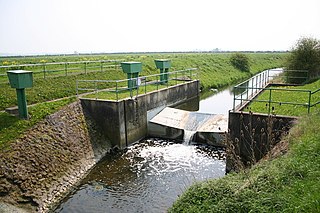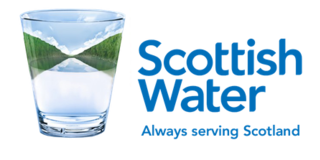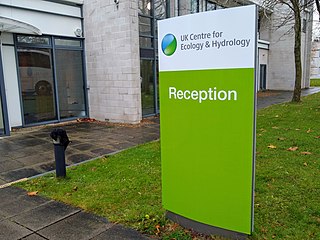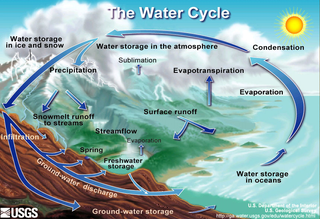Related Research Articles

A stream gauge, streamgage or stream gauging station is a location used by hydrologists or environmental scientists to monitor and test terrestrial bodies of water. Hydrometric measurements of water level surface elevation ("stage") and/or volumetric discharge (flow) are generally taken and observations of biota and water quality may also be made. The locations of gauging stations are often found on topographical maps. Some gauging stations are highly automated and may include telemetry capability transmitted to a central data logging facility.

Water quality refers to the chemical, physical, and biological characteristics of water based on the standards of its usage. It is most frequently used by reference to a set of standards against which compliance, generally achieved through treatment of the water, can be assessed. The most common standards used to monitor and assess water quality convey the health of ecosystems, safety of human contact, extent of water pollution and condition of drinking water. Water quality has a significant impact on water supply and oftentimes determines supply options.
The Environment Agency (EA) is a non-departmental public body, established in 1996 and sponsored by the United Kingdom government's Department for Environment, Food and Rural Affairs, with responsibilities relating to the protection and enhancement of the environment in England.

A bioindicator is any species or group of species whose function, population, or status can reveal the qualitative status of the environment. The most common indicator species are animals. For example, copepods and other small water crustaceans that are present in many water bodies can be monitored for changes that may indicate a problem within their ecosystem. Bioindicators can tell us about the cumulative effects of different pollutants in the ecosystem and about how long a problem may have been present, which physical and chemical testing cannot.
RIVPACS is an aquatic biomonitoring system for assessing water quality in freshwater rivers in the United Kingdom. It is based on the macroinvertebrate species found at the study site during sampling. Some of these species are tolerant to pollution, low dissolved oxygen, and other stressors, but others are sensitive; organisms vary in their tolerances. Therefore, different species will usually be found, in different proportions, at different river sites of varying quality. Some organisms are especially good indicator species. The species found at the reference sites collectively make up the species assemblage for that site and are the basis for a statistical comparison between reference sites and non-reference sites. The comparison between the expected species and the observed species can then be used to estimate this aspect of the ecological health of a river.

Scottish Water is a statutory corporation that provides water and sewerage services across Scotland. It is accountable to the public through the Scottish Government.

The Scottish Environment Protection Agency is Scotland's environmental regulator and national flood forecasting, flood warning and strategic flood risk management authority. Its main role is to protect and improve Scotland's environment. SEPA does this by helping business and industry to understand their environmental responsibilities, enabling customers to comply with legislation and good practice and to realise the economic benefits of good environmental practice. One of the ways SEPA does this is through the NetRegs environmental guidance service. It protects communities by regulating activities that can cause harmful pollution and by monitoring the quality of Scotland's air, land and water. The regulations it implements also cover the storage, transport and disposal of radioactive materials.

The UK Centre for Ecology & Hydrology (UKCEH) is a centre for excellence in environmental science across water, land and air. The organisation has a long history of investigating, monitoring and modelling environmental change. Research topics include: air pollution, biodiversity, chemical risks in the environment, extreme weather events, droughts, floods, greenhouse gas emissions, soil health, sustainable agriculture, sustainable ecosystems, water quality, and water resources management.
Public water supply and sanitation in the United Kingdom is characterised by universal access and generally good service quality. A salient feature of the sector in the United Kingdom compared to other developed countries is the diversity of institutional arrangements between the constituting parts of the UK, which are each described in separate articles, while this article is devoted to some common issues across the United Kingdom.

The Water Framework Directive2000/60/EC is an EU directive which commits European Union member states to achieve good qualitative and quantitative status of all water bodies by 2015. It is a framework in the sense that it prescribes steps to reach the common goal rather than adopting the more traditional limit value approach. The Directive's aim for 'good status' for all water bodies will not be achieved, with 47% of EU water bodies covered by the Directive failing to achieve the aim.
Environmental Quality is a set of properties and characteristics of the environment, either generalized or local, as they impinge on human beings and other organisms. It is a measure of the condition of an environment relative to the requirements of one or more species, any human need or purpose.
Fluvidona anodonta or more commonly known as the North Pine River freshwater snail is a species of minute freshwater snail that is endemic to Australia. Originally discovered in 1892 by Hedley & Musson, the snail is highly elusive and only has been sighted four times since its discovery. The snail is 2 mm long and 1 mm wide with the shell colouring being of a yellow-whiteish shade. Fluvidona anodonta resides within the City of Moreton Bay, specifically in four river systems within the D'Aguilar National Park, Queensland. The four river systems are the South Pine River headwaters, the North Pine River headwaters, Kobble Creek and Low Branch Creek. The snail is found under deeply submerged rocks within permanent freshwater systems.

The Scottish Government's Marine Directorate is responsible for managing Scotland's seas and freshwater fisheries along with delivery partners NatureScot and the Scottish Environment Protection Agency.

Freshwater environmental quality parameters are those chemical, physical or biological parameters that can be used to characterise a freshwater body. Because almost all water bodies are dynamic in their composition, the relevant quality parameters are typically expressed as a range of expected concentrations.

Environmental monitoring describes the processes and activities that need to take place to characterize and monitor the quality of the environment. Environmental monitoring is used in the preparation of environmental impact assessments, as well as in many circumstances in which human activities carry a risk of harmful effects on the natural environment. All monitoring strategies and programs have reasons and justifications which are often designed to establish the current status of an environment or to establish trends in environmental parameters. In all cases, the results of monitoring will be reviewed, analyzed statistically, and published. The design of a monitoring program must therefore have regard to the final use of the data before monitoring starts.

Water pollution in New Zealand is an increasing concern for those who use and care for waterways and for New Zealand regulatory bodies. An increase in population is linked to an increase in water pollution, due to a range of causes such as rural land use, industrial use and urban development. Fresh water quality is under pressure from agriculture, hydropower, urban development, pest invasions and climate change. While pollution from point sources has been reduced, diffuse pollution such as nutrients, pathogens and sediments development and from stormwater in towns is not under control. There are more than 800 water quality monitoring sites around New Zealand that are regularly sampled.
Water chemistry analyses are carried out to identify and quantify the chemical components and properties of water samples. The type and sensitivity of the analysis depends on the purpose of the analysis and the anticipated use of the water. Chemical water analysis is carried out on water used in industrial processes, on waste-water stream, on rivers and stream, on rainfall and on the sea. In all cases the results of the analysis provides information that can be used to make decisions or to provide re-assurance that conditions are as expected. The analytical parameters selected are chosen to be appropriate for the decision making process or to establish acceptable normality. Water chemistry analysis is often the groundwork of studies of water quality, pollution, hydrology and geothermal waters. Analytical methods routinely used can detect and measure all the natural elements and their inorganic compounds and a very wide range of organic chemical species using methods such as gas chromatography and mass spectrometry. In water treatment plants producing drinking water and in some industrial processes using products with distinctive taste and odours, specialised organoleptic methods may be used to detect smells at very low concentrations.
Analytical quality control, commonly shortened to AQC, refers to all those processes and procedures designed to ensure that the results of laboratory analysis are consistent, comparable, accurate and within specified limits of precision. Constituents submitted to the analytical laboratory must be accurately described to avoid faulty interpretations, approximations, or incorrect results. The qualitative and quantitative data generated from the laboratory can then be used for decision making. In the chemical sense, quantitative analysis refers to the measurement of the amount or concentration of an element or chemical compound in a matrix that differs from the element or compound. Fields such as industry, medicine, and law enforcement can make use of AQC.
The Biodiversity Monitoring Switzerland (BDM) is a Swiss Confederation programme for the long-term monitoring of species diversity in Switzerland.
The National Atmospheric Deposition Program (NADP) is a Cooperative Research Support Program of the State Agricultural Experiment Stations (NRSP-3). Housed at the Wisconsin State Laboratory of Hygiene at the University of Wisconsin–Madison, the NADP is a collaborative effort between many different groups as : Federal, state, tribal, and local governmental agencies, as educational institutions, private companies, and non-governmental agencies. These organizations work together in order to operate monitoring sites and report deposition data. The NADP provides free and easy access to all of its data, including seasonal and annual averages, trend plots, deposition maps, reports, manuals, and educational brochures.
References
- ↑ DEFRA - Freshwater quality - Harmonised Monitoring Scheme Archived 2013-04-02 at the UK Government Web Archive
- ↑ "Accuracy of determination of chloride in river waters: Analytical Quality Control in the Harmonised Monitoring Scheme". pubs.rsc.org. 104 (1237): 290–298. 1979. Bibcode:1979Ana...104..290.. doi:10.1039/AN9790400290 . Retrieved 30 August 2022.
- ↑ "Co-ordination of analytical control for DOE Harmonised monitoring scheme" (PDF). dwi-content.s3.eu-west-2.amazonaws.com. Retrieved 30 August 2022.
- ↑ "ENV-16 Harmonised Monitoring Scheme datasets". www.gov.uk. 15 October 2014. Retrieved 1 September 2022.
- ↑ "State of the water environment: long-term trends in river quality in England". 2023-05-22. Retrieved 2023-08-31.
- ↑ "SEPA -Scottish River water quality trends". www.sepa.org.uk. Archived from the original on 2011-09-18. Retrieved 2011-07-30.